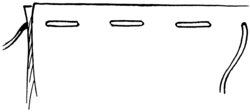Difference between revisions of "AY Honors/Dressmaking/Answer Key"
From Pathfinder Wiki
< AY Honors | DressmakingAY Honors/Dressmaking/Answer Key
(Undid revision 248923077 by Weeliljimmy (talk)) |
|||
| Line 1: | Line 1: | ||
| − | + | [[Image:Basting (PSF).png|right|250px]] | |
| − | + | In [[sewing]], to '''tack''' or '''baste''' is to make quick, temporary [[stitch]]ing intended to be removed. Tacking is used in a variety of ways: | |
| − | |||
| − | |||
| − | |||
| − | + | * To temporarily hold a [[seam]] or [[trim (sewing)|trim]] in place until it can be permanently sewn, usually with a long [[running stitch]] made by hand or [[sewing machine|machine]] called a '''tacking stitch''' or '''basting stitch'''. | |
| − | [[ | + | * To temporarily attach a [[lace]] [[collar (clothing)|collar]], [[ruffle]]s, or other trim to [[clothing]] so that the attached article may be removed easily for cleaning or to be worn with a different garment. For this purpose, tacking stitches are sewn by hand in such a way that they are almost invisible from the outside of the garment. |
| − | + | * To transfer [[pattern (sewing)|pattern markings]] to [[textile|fabric]], or to otherwise mark the point where two pieces of fabric are to be joined. A special loose looped stitch used for this purpose is called a '''tack''' or '''tailor's tack'''. | |
| − | The | + | * A basting stitch is essentially a straight stitch, sewn with long stitches and unfinished ends. The basting stitch is used for temporarily holding sandwiched pieces of fabric in place. The stitch is removed after the piece is finished. Often used in [[quilting]] or [[embroidery]]. |
| − | |||
| − | |||
| − | |||
| − | [ | + | == External references == |
| + | [http://www.alternative-windows.com/stitches.htm Tacking stitch] | ||
| + | |||
| + | {{sewing}} | ||
[[Category:Sewing stitches]] | [[Category:Sewing stitches]] | ||
| − | + | {{textile-arts-stub}} | |
| − | + | and that is how you tack stitch | |
| − | |||
| − | |||
Revision as of 13:33, 20 November 2008
In sewing, to tack or baste is to make quick, temporary stitching intended to be removed. Tacking is used in a variety of ways:
- To temporarily hold a seam or trim in place until it can be permanently sewn, usually with a long running stitch made by hand or machine called a tacking stitch or basting stitch.
- To temporarily attach a lace collar, ruffles, or other trim to clothing so that the attached article may be removed easily for cleaning or to be worn with a different garment. For this purpose, tacking stitches are sewn by hand in such a way that they are almost invisible from the outside of the garment.
- To transfer pattern markings to fabric, or to otherwise mark the point where two pieces of fabric are to be joined. A special loose looped stitch used for this purpose is called a tack or tailor's tack.
- A basting stitch is essentially a straight stitch, sewn with long stitches and unfinished ends. The basting stitch is used for temporarily holding sandwiched pieces of fabric in place. The stitch is removed after the piece is finished. Often used in quilting or embroidery.
External references
Template:Textile-arts-stub and that is how you tack stitch

